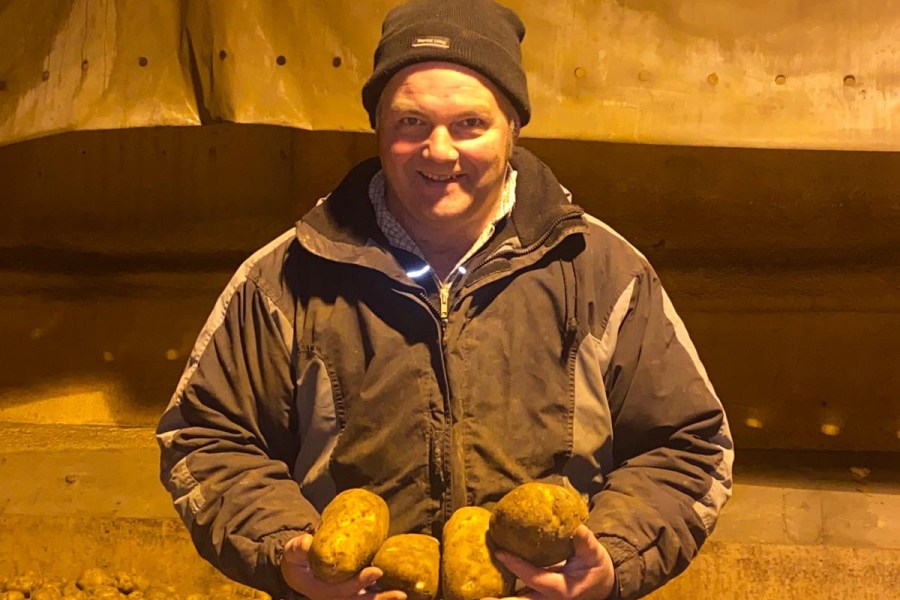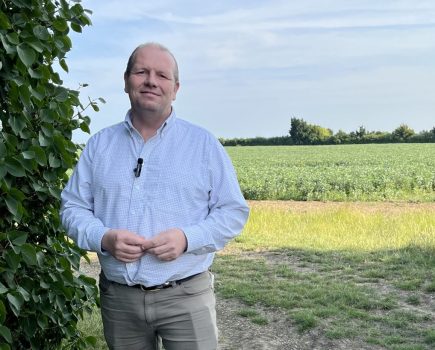by Andrew Wilson
Well, we started this month ahead of usual but things have a habit of upskittling themselves at times, and as things stand we’ve not yet started harvesting potatoes, despite half of them being ready.
Since we lost diquat, our desiccation method has been to flail and spray with carfentrazone on a sunny day. The important part here is the sunshine – if it isn’t bright, it just doesn’t work. The bonus to this approach is the press wheels on the back of our topper close up any ridge cracks where light might get in to prevent greening.
Yield digs suggest our heavier land will be better performing than the light, and land in a long rotation will fare better than that in a short one. This isn’t a surprise, but has been exacerbated this year somewhat.
One pleasant surprise, given the heat and high physiological age, is the lack of daughter tubers sprouting in the row. Skins are mostly nicely set, but the dry matter of some varieties remains stubbornly high, so for all we now have some moisture, we must be gentle when harvesting and vigilant in store. There’ll be no extra tonnage this year to cushion the blow of any mistakes, every taty counts.
Drilling has gone well this season, although we’ve parked the disc drill up and are currently using our strip-till to sow into subsoiled and cultipressed seedbeds in the main. This deeper cultivation alongside the leading leg-style drill ought to enable better drainage this winter, in an attempt to not lose a crop to flooding. Tungsten and Ferobide have shown their worth in the hard dry conditions we’ve had this autumn.
On the face of current prices, a wise farmer would perhaps restrain from sowing crops just now. The state of the market was brought to my attention recently when somebody pointed out that a tonne of grain used to pay a farmhand for a week, whereas now it barely pays for a day. Machinery has doubled in price in 10 years, and as for the fertiliser market antics in recent times, well, a man could swear!
In austere times like these it’s easy to put the brakes on investment, lock the cheque book away and say no more. The bother with that is everything finishes up worn out at the same time. During the past 10 years or so we’ve grown our fleet of tractors rather than necessarily replace them. This has come about as new prices have risen to unaffordable levels, and we’ve tended to spend the ‘cost to change’ (or a bit less) on an addition to the fleet and retain what would have been the outgoing machine.
This has brought significant flexibility and convenience, particularly given we do everything here in-house except sugar beet harvesting, and have some tractors on row crop wheels for a chunk of the year. It allows flexibility, in-house back up and convenience too.
Average clock hours across our seven main tractors are around 8600, at an average age of 16 years, the newest being seven-years-old. None have under 5000 hours, only one has over 10,000 hours, but three have amassed more than 9000. We’ve considered various solutions including hiring or buying a new one, but a quote some months ago soon had that idea off the table.
In my experience, older tractors don’t break much more than new ones if you keep maintenance up to scratch. So we try to keep on top of the niggly jobs that need doing so they don’t become big ones, and like them to be tidy and fully functional.
Our most recent new tractor was purchased in 2015 and at this point I can’t see a time when we’ll repeat that experience, although I hope somebody does, or the supply of second-hand machines will dry up.
Depending on requirements at the time, we’ve bought young, old, high and low houred tractors, and have no issue running reliable machines into the teens of thousands of clock hours. I wasn’t overly looking to make a purchase just now, but a very tidy 10-year-old example came up for auction locally which fitted the bill perfectly, so I did some research, spoke to my friendly finance company, and set myself a limit.
The trade was keen for such a smart machine, but so was I, and home she came. The reason for the auction is a sad one – the family hosting the sale was faced with a situation where its generations didn’t pass on in the traditional order. Difficult decisions and changes had to be made to allow life to continue in a sensible fashion.
If nothing else, this illustrates the fragility of life. Us farmers farm as if we’re going to live forever, but in reality, we are but a speck in time. I just aim to do my bit and leave this place in better condition than when I started, not dissimilar to a lot of people, I guess.
Still on the subject of machinery, you may remember ‘Twinkle toes’ joining our sprayer armoury last winter? It’s a lightweight hydrostatic sprayer bought for flexibility and to increase capacity and capability to our operation.
What I underestimated was the convenience of having two sprayers – the larger trailed machine is currently still on narrow wheels as we finish desiccating potatoes, and Twinkle is on flotations doing pre-em herbicides on the cereals. The downside is 1990s technology is a step back in time.
Here’s to a fruitful, hassle free (hah) and above all, safe, potato harvest.
This article was taken from the latest issue of CPM. Read the article in full here.
For more articles like this, subscribe here.
Sign up for Crop Production Magazine’s FREE e-newsletter here.




